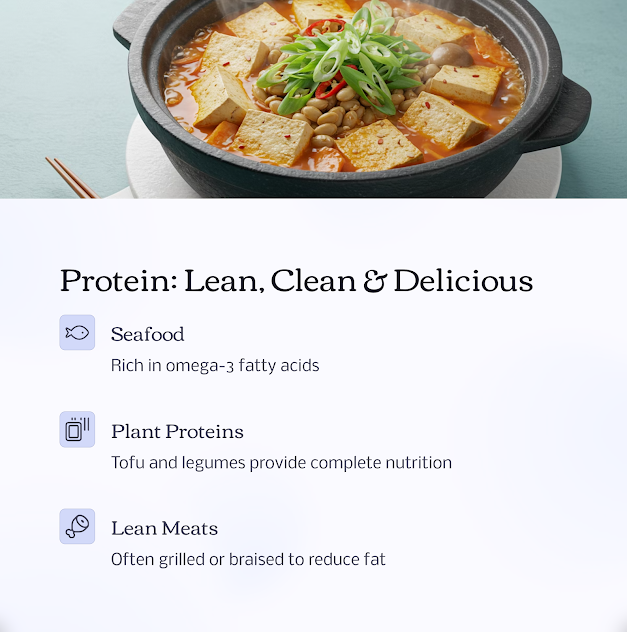Korean cuisine is globally loved for its bold flavors, colorful presentation, and diverse ingredients.
But is it actually healthy? Let's break down the facts and discover how nutritious Korean food really is.
What Makes Korean Cuisine a Nutritional Powerhouse?
Korean food is often praised for its balance of flavors and nutrient-rich ingredients.
It features a high intake of vegetables, fermented foods like kimchi, and cooking methods that avoid excessive oil or sugar.
In this article, we’ll explore the core components of Korean meals, their nutritional benefits, and what to watch out for if you're health-conscious.
Traditional Korean Meals Are Naturally Balanced
A typical Korean meal includes rice, soup, vegetables, and a protein source like tofu, fish, or meat.
This structure emphasizes nutritional balance:
carbohydrates from rice, fiber and antioxidants from vegetables, and protein from lean meats or legumes.
"The variety in each meal provides a wide spectrum of vitamins and minerals."
Fermented Foods Boost Gut Health
One of the defining traits of Korean cuisine is its use of fermented foods like kimchi, doenjang (soybean paste), and gochujang (red pepper paste).
Fermented foods are rich in probiotics, which aid digestion and support a healthy gut microbiome.
They also contain vitamins B and C, along with beneficial enzymes.
However, some fermented items can be high in sodium, so moderation is key.
The Role of Vegetables in Korean Dishes
Vegetables are central to Korean meals — often served as side dishes (banchan) or incorporated into main dishes.
| Vegetable | Nutritional Benefit |
|---|---|
| Spinach (sigeumchi) | Iron, vitamin A, folate |
| Bean sprouts (kongnamul) | Low calorie, high in fiber |
| Napa cabbage (baechu) | Vitamin K, antioxidants |
| Zucchini (hobak) | Potassium, vitamin C |
Key point: Korean cuisine naturally encourages high vegetable intake without relying on heavy sauces or cheese.
Protein Sources: Lean and Varied
Protein in Korean food often comes from fish, tofu, egg, legumes, or lean meats like pork and chicken.
Grilled, steamed, or braised cooking methods help reduce fat content.
While Korean BBQ is a fan favorite, it's best enjoyed occasionally due to high sodium marinades and fatty cuts.
For daily meals, dishes like doenjang jjigae (soybean stew) or bulgogi with vegetables provide a healthier protein option.
Hidden Calories: What to Watch For
Despite its benefits, not all Korean food is low in calories or sodium.
| Item | Health Concern |
|---|---|
| Tteokbokki | High in sugar and starch |
| Instant ramen | High sodium, low fiber |
| Fried mandu | Deep-fried, high in fat |
| Jajangmyeon | Heavy sauce, refined carbs |
If you're watching your weight or blood pressure, these should be occasional treats.
Choose boiled, grilled, or steamed versions over deep-fried or heavily sauced dishes.
Low-Sugar, High-Fiber Advantage
Unlike many Western meals, Korean cuisine generally avoids added sugars in everyday dishes.
Instead, sweetness comes from natural sources like fruit, onions, or mildly sweet sauces.
The emphasis on whole grains (e.g., multigrain rice), fiber-rich veggies, and fermented sides contributes to better blood sugar control.
Q&A: Korean Food and Diet Goals
Q: Is Korean food good for weight loss?
A: Yes, when you focus on vegetable-heavy dishes, fermented sides, and moderate rice portions.
Q: Is kimchi too salty to eat every day?
A: It is high in sodium, so keep portions small (about 1–2 tablespoons) and balance with fresh veggies.
Q: Are all Korean soups healthy?
A: Many are nutritious, but some like budae jjigae (army stew) can be high in sodium and processed meats.
Final Take: Korean Food Can Be Exceptionally Healthy
When eaten in traditional form, Korean cuisine supports gut health, weight management, and nutrient diversity.
The key is to choose fresh, minimally processed dishes and limit high-fat or salty items.
Whether you're following a balanced diet or aiming for wellness, Korean food offers a satisfying and nourishing way to eat well every day.










